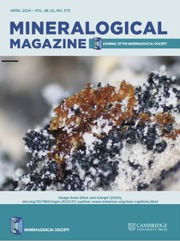Crossref Citations
This article has been cited by the following publications. This list is generated based on data provided by
Crossref.
Zenobi, Renato
Philippoz, Jean-Michel
Zare, Richard N.
and
Buseck, Peter R.
1989.
Spatially Resolved Organic Analysis of the Allende Meteorite.
Science,
Vol. 246,
Issue. 4933,
p.
1026.
Hinton, R.W.
1990.
Ion microprobe trace-element analysis of silicates: Measurement of multi-element glasses.
Chemical Geology,
Vol. 83,
Issue. 1-2,
p.
11.
Reed, S.J.B.
1990.
Recent developments in geochemical microanalysis.
Chemical Geology,
Vol. 83,
Issue. 1-2,
p.
1.
De Laeter, John R.
1990.
Mass spectrometry in cosmochemistry.
Mass Spectrometry Reviews,
Vol. 9,
Issue. 4,
p.
453.
MacRAE, N.D.
and
WU, T‐W
1990.
Determination of the Rare Earth Elements in Thirteen GSJ Silicate Rock Reference Samples by Secondary Ion Mass Spectrometry.
Geostandards Newsletter,
Vol. 14,
Issue. 1,
p.
119.
BOTTAZZI, P.
OTTOLINI, L.
and
VANNUCCI, R.
1991.
Determination of Rare Earth Elements in Sixteen Silicate Reference Samples by Secondary Ion Mass Spectrometry Using Conventional Energy Filtering Technique*.
Geostandards Newsletter,
Vol. 15,
Issue. 1,
p.
51.
Brown, B. E.
Tudhope, A. W.
Le Tissier, M. D. A.
and
Scoffin, T. P.
1991.
A novel mechanism for iron incorporation into coral skeletons.
Coral Reefs,
Vol. 10,
Issue. 4,
p.
211.
Elphick, S. C.
Graham, C. M.
Walker, F. D. L.
and
Holness, M. B.
1991.
The application of SIMS ion imaging techniques in the experimental study of fluid-mineral interactions.
Mineralogical Magazine,
Vol. 55,
Issue. 380,
p.
347.
Pillinger, C.T.
1992.
Advances in Mass Spectrometry.
p.
477.
De Laeter, John R.
De Bièvre, Paul
and
Peiser, H. S.
1992.
Isotope mass spectrometry in metrology.
Mass Spectrometry Reviews,
Vol. 11,
Issue. 3,
p.
193.
OTTOLINI, Luisa
BOTTAZZI, Piero
VANNUCCI, Riccardo
and
ODDONE, Massimo
1992.
AN ION PROBE CONTRIBUTION TO RARE EARTH ELEMENT INVESTIGATION OF GABBRO GOG‐1 USING SECONDARY ION MASS SPECTROMETRY.
Geostandards Newsletter,
Vol. 16,
Issue. 1,
p.
13.
Bottazzi, Piero
Ottolini, Luisa
and
Vannucci, Riccardo
1992.
SIMS analyses of rare earth elements in natural minerals and glasses: An investigation of structural matrix effects on ion yields.
Scanning,
Vol. 14,
Issue. 3,
p.
160.
Pillinger, C.T.
1992.
New technologies for small sample stable isotope measurement: static vacuum gas source mass spectrometry, laser probes, ion probes and gas chromatography-isotope ratio mass spectrometry.
International Journal of Mass Spectrometry and Ion Processes,
Vol. 118-119,
Issue. ,
p.
477.
MacRae, N.D.
Bottazzi, P.
Ottolini, L.
and
Vannucci, R.
1993.
Quantitative REE analysis of silicates by SIMS: Conventional energy filtering vs. specimen isolation mode.
Chemical Geology,
Vol. 103,
Issue. 1-4,
p.
45.
Domanik, Kenneth J.
Hervig, Richard L.
and
Peacock, Simon M.
1993.
Beryllium and boron in subduction zone minerals: An ion microprobe study.
Geochimica et Cosmochimica Acta,
Vol. 57,
Issue. 21-22,
p.
4997.
Voumard, Pierre
Zhan, Qiao
and
Zenobi, Renato
1993.
A new instrument for spatially resolved laser desorption/laser multiphoton ionization mass spectrometry.
Review of Scientific Instruments,
Vol. 64,
Issue. 8,
p.
2215.
Asher, S. E.
1994.
Microanalysis of Solids.
p.
149.
Sie, S.H.
and
Suter, G.F.
1994.
A microbeam AMS system for mineralogical applications.
Nuclear Instruments and Methods in Physics Research Section B: Beam Interactions with Materials and Atoms,
Vol. 92,
Issue. 1-4,
p.
221.
Green, Trevor H.
1994.
Experimental studies of trace-element partitioning applicable to igneous petrogenesis — Sedona 16 years later.
Chemical Geology,
Vol. 117,
Issue. 1-4,
p.
1.
Smith, Joseph V.
1994.
Feldspars and their Reactions.
p.
541.

